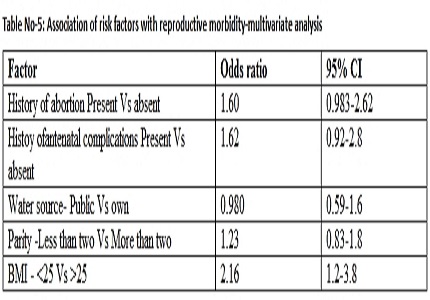Prevalence of reproductive morbidity and its determinants among ever married women of reproductive age group (15-45 years) in a rural area of Kozhikode
Abstract
Background: Reproductive ill health contributes about 20% of global burden of ill health among women. To achieve the goal of universal access to reproductive health, the burden of the illness and their risk factors should be assessed in different areas.
Objectives: To study the prevalence and association of demographic and other factors with self reported reproductive morbidity among married women of reproductive age group; 15- 45 years.
Methodology: A cross sectional study was conducted among 600 ever married females in the field practice area of Department of Community Medicine. Cluster sampling method was adopted. Using structured schedule, interview of the selected female from one house was conducted by the same female investigator. Data analysed using SPSS 16.
Results: 378 (63%) of the women were in the age between 20-35 years. Mean age of the women was 31.5+ 0.7.6 years. Prevalence of reproductive morbidity was 30.5% (95% CI 26% - 34.99%). 167 (27.8%) women had gynecological morbidity, and 8 women had obstetric morbidity i.e. 1.3% and prevalence of contraceptive morbidity was 8 (1.3%).
Conclusion: Reproductive health problems are prevalent in this community. More than one fourth of the women reported at least one type of gynaecological morbidity which is a high prevalence. Socio demographic factors have some role in the prevalence of reproductive morbidity such as age, religion, occupation, housing standards, socio economic status, co habitation status. Others included early age at menarche, early age at marriage, bad obstetric history, increased parity, history of menstrual abnormality and poor nutritional status.
Downloads
References
2. Bansal K M, Singh K, Bhatnagar S, Prevalence of lower reproductive tract infections among married females in the reproductive age group(15-45), Health Population perceptive Issues 2001, 24, 157-63.
3. WHO world health strategy, 2004, WHO/RHR/04.8
4. Wilhelmson, and Gerdtham, (2006:7). The World Health Report, Make Every Mother and Child Count. Switzerland, Geneva: WHO.
5. Newsletter of the Department of Reproductive Health and Research of the World Health Organization (WHO, 2001).
6. Report of National family Health Survey 2, 1998-99.
7. District Level household Facility Survey 3, 2007-08, MoHFW, International institute for population sciences, Fact sheet.
8. Bhatia J C, Cleland T ; Bulletin of WHO, 2001 volume 79 (11) pages 1065-1069. [PubMed]
9. Newsletter of the Department of Reproductive Health and Research of the World Health Organization (WHO, 2001).
10. Pareek U, Trivedi G. Manual of socio-economic status scale (rural). New Delhi, Manasayan Publishers, 1995.
11. Shaws Text Book of Gynaecology 12th edition, chapter 17.
12. Sowmini C. V, Sankara Sharma et al, Reproductive morbidity among contraceptive users : Need for quality services; The Journal of Family Welfare, vol 50, No1, June 2004. [PubMed]
13. Saurabh Singh, Dr. S. K. Singh et al Reproductive Morbidity among the Rural Women in Maharastra http://www.iipsindia.org/pub/ssp/sauravsingh.pdf
14. Monika Rathore, Leela Vyas, Prevalence of Reproductive Tract Infections amongst Ever Married Women and Sociocultural Factors Associated with It. J Indian Med Assoc 2007; 105: 71-4 & 78.
15. Mulgaonkar, Veena B.: Reproductive Health of Women in Urban Slums of Bombay. Social Change. Sept-Dec 1996. 26(3 & 4). p.137-156.
16. Indra P. Kambo, B.S. Dhillon et al, Self-Reported Gynecological Problems from Twenty-Three Districts in India (An ICMR Task Force Study), Indian Journal of Community Medicine, Vol. 28, No. 2 (2003-04 - 2003-06).
17. Kannan C, Athmaraman TN, Nayeem Abdul, Sangeetha S, Sudha R, Ponsuganthi K, Murugan K et al Prevalence of reproductive tract infections among recently married women in Veerapandi Panchayat union of Salem district, Tamil Nadu Indian Journal of Community Medicine 2007, vol 32, issue 2, 144-145.
18. Savita Sharma, BP Gupta et al The Prevalence of Reproductive Tract Infections and Sexually Transmitted Diseases Among Married Women in the Reproductive Age Group in a Rural Area , IIndian Journal of Community Medicine / Vol 34 / Issue 1 / January 2009
19. D. Pandit et al, ―Morbidity Pattern of Women Attending Screening Program in an Urban Slum in Mumbai‖, Indian Journal of Community Medicine, Vol. 30, No. 4 (2005-10 - 2005-12)
20. Bhatia JC, Cleland J. Obstetric morbidity in south India: results from a community survey. Soc Sci Med. 1996 Nov;43(10):1507-16. [PubMed]
21. Dasgupta Aparajita Sarkar Madhutandra et al. A study on reproductive tract infections among married women in the reproductive age group (15-45 years) in a slum of Kolkata. J Obstet Gynecol India Vol. 58, No. 6 : November/December 2008 pg 518-522.
22. A. S. Dey et al , PRC Research Monograph: Level and Determinants of Reproductive Morbidity in Madhya Pradesh, Population Research Centres, PRC Division, Ministry of Health & Family Welfare Government of India, 26-8-2009.
23. Santosh Kumar Gupta1, Rajiva Prasad et al, Reproductive Morbidity among Currently Married Women in EAG States: Evidence from the Reproductive and Child Health survey 2002-2004,IIPS

Copyright (c) 2017 Author (s). Published by Siddharth Health Research and Social Welfare Society

This work is licensed under a Creative Commons Attribution 4.0 International License.


 OAI - Open Archives Initiative
OAI - Open Archives Initiative


